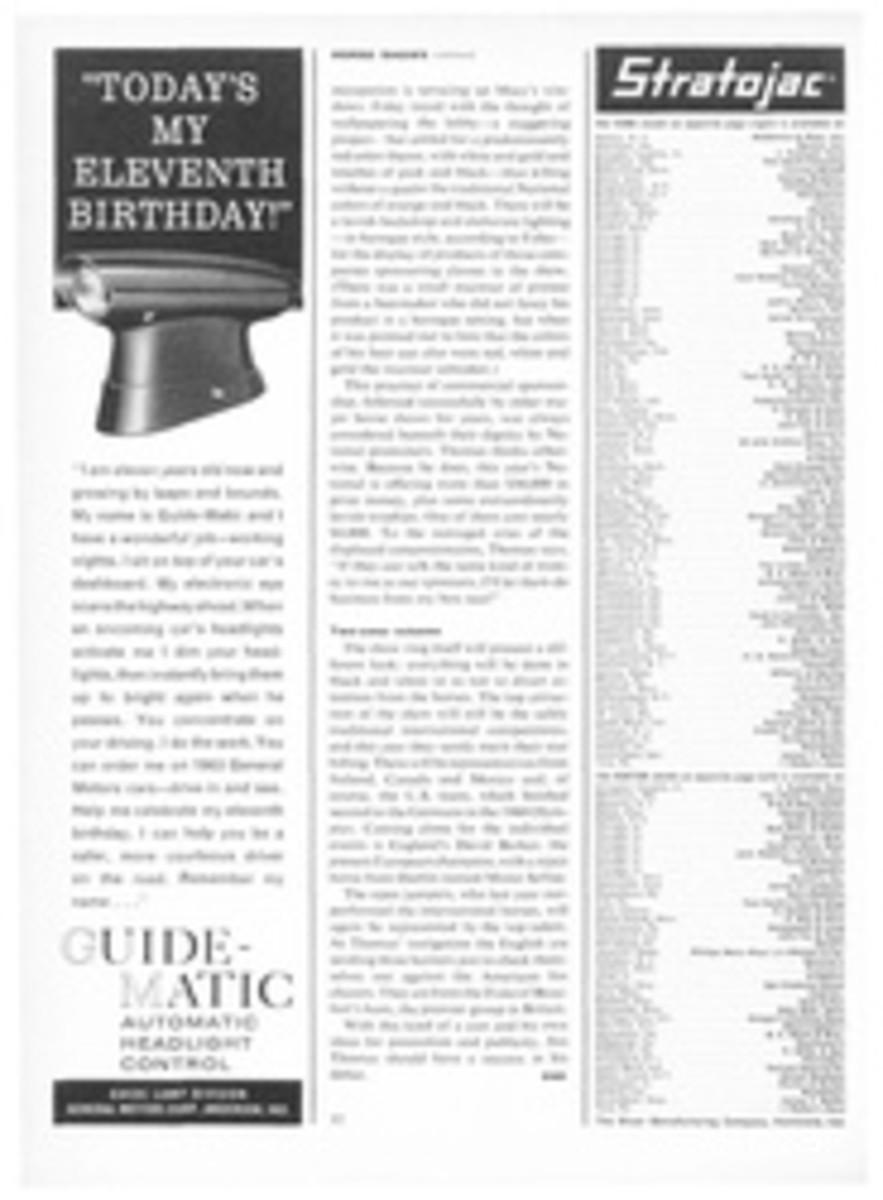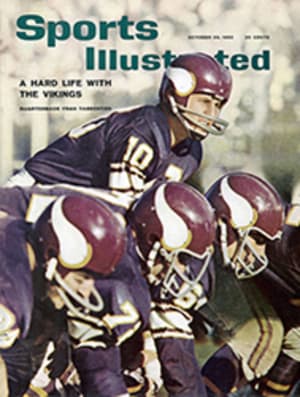
Pistol Pete Meets Preacher Pilot
Pistol Pete Pedro and Preacher Pilot met last Saturday night in Canyon, Texas, and if that doesn't mean anything special to you, you don't live in the Texas Panhandle or the Rio Grande Valley of New Mexico. Preacher Pilot is a halfback at New Mexico State University and last year, as a sophomore, he gained more yards rushing than any other back in the country—including All-Americas Ernie Davis, Jimmy Saxton and Bob Ferguson—and he also scored the most points. Pistol Pete Pedro is a halfback at West Texas State and last year, as a sophomore, he gained more yards and scored more points than anybody in the country except Preacher Pilot.
Last Saturday night Pistol Pete and the Preacher attracted the largest crowd ever to watch a college football game in the lightly populated Panhandle. The crowd came partly because the home team, West Texas, was undefeated and untied, and partly because New Mexico is a longtime love-to-hate-you rival. But mostly the people came to see Pedro and Pilot. When the two met a year ago West Texas won 35-22, and the Pistol and the Preacher had more or less of a draw in their personal duel, each scoring two touchdowns. Over the season Pistol Pete had a little the better of it in praise and publicity, but the Preacher came on strong in his last game to lock up both the rushing and scoring titles. In that game, against Hardin-Simmons, he carried the ball 40 times, gained 319 yards, scored three touchdowns, and six times carried the ball and scored on two-point tries for extra points. Preacher thus won the rushing championship handily and edged out Pistol Pete in scoring by six points.
Preacher Pilot's first name is James. The nickname was given to him by his grandmother when he was a small boy in Kingsville, Texas, near Corpus Christi, and it has stayed with him. He was one of the first Negroes ever to play for Kingsville High School, and he led the team all the way to the finals of the state championship before it lost out. He was besieged with football scholarship offers, nearly 50 in all, and he finally chose Kansas. He played on the Kansas freshman team, joined a fraternity that numbered among its brother's Wilt (The Stilt) Chamberlain and had trouble with his grades.
"I finally left," Preacher said, "and went back home to Kingsville. My high school coach was disappointed in me, but he called Coach Woodson at New Mexico State. Coach Woodson was good to me. He arranged for me to go there." Pilot is 5 feet 11 inches tall and weighs 195 pounds, just about the size of Mickey Mantle. He has the same trim, blocky build that Mantle has and possibly as much speed. He was clocked at 9.8 in the 100-yard dash in high school. He has a deep resonant voice, a fine, sharp wit and extraordinary poise. He hopes to play pro football.
Pistol Pete Pedro's real name is Peter Charles Pedro. Despite his nickname, Pistol Pete is no son of the West. He was born in Cambridge, Mass., the son of Puerto Rican parents, and he grew up in Lynn, just north of Boston, a few hundred yards from the saltwater of Massachusetts Bay. He likes clams and scallops, and he has a Boston accent.
Pedro is tiny as football players go—5 feet 8 inches tall, 160 pounds—but he is very strong and tremendously fast and he can change direction like a fish. Hank Foldberg, coach at Texas A&M who played end on the memorable Army teams of the mid-1940s, said last season that Pedro was the best running back he had seen since Glenn Davis. Pedro was a high school star at Lynn Trade School but he was overlooked at football-scholarship time, primarily because Lynn Trade is undistinguished athletically and because football coaches seldom gamble their athletic scholarships on players as small as Pete Pedro. He followed a friend out to Trinidad State Junior College in Colorado but left after one semester and went back home to Lynn for a year. About this time Joe Kerbel had just finished his first year as head coach at West Texas, and he felt that he needed a really speedy back to make his offense go. He asked around and a friend in California told him that he had heard of a prettyfast back at Trinidad Junior College. Kerbel phoned Trinidad, got Pedro's address, phoned Lynn and eventually arranged for Pete to transfer his credits from Trinidad to West Texas.
And so the wanderings of Pedro and Pilot came together in time and place, and the cultural pleasures of the Southwest were immeasurably enriched.
Still good
This year everyone was looking forward to a renewal of the feud. Preacher Pilot, running behind a much weaker New Mexico State team, fell off from his totals of last season, but he was still fourth in the country in yards gained rushing. Pistol Pete Pedro, helped by a West Texas team that swept its first five games, piled up a big lead in rushing yardage and was scoring at a fast rate, although Teammate Jerry Logan, a tall, rangy halfback, took over the national scoring lead.
Then trouble began to peck at things. Pistol Pete twisted an ankle and tore a transverse ligament two weeks before the meeting with Preacher and New Mexico State. He did not play in the West Texas-Arizona State game in Phoenix, which caused an uproar—the people in Arizona had been waiting all year to see Pedro run. Then reports from New Mexico said that Warren Woodson, disgusted with his team's performance—three defeats in five games—was talking about shaking things up and maybe using sophomore Woody Houston in Preacher Pilot's place in the starting backfield. And in Texas a great drenching Panhandle rain left the football stadium in Canyon as soggy as a dishcloth.
Then the sun came out, and a drying wind blew down across the Panhandle. Pete Pedro took his ankle to the doctor for a treatment, worked out and seemed improved. New Mexico State arrived in town and members of the advance guard hinted that Woodson's demotion of Preacher to the defense was psychological warfare and that it wouldn't last past the second play from scrimmage. An edgy Woodson wanted badly to beat Kerbel. A nervous Kerbel worried about an upset. Delighted spectators crowded the advance ticket windows.
They didn't see a great ball game in Canyon's Buffalo Bowl last Saturday night, though they did experience an exciting and satisfactory one, since West Texas won, 20-12. Neither did they witness an epic Pedro-Pilot duel, but they did see enough to appreciate all over again the special qualities that draw people to watch these remarkable athletes.
Pistol Pete was used principally as a decoy. Even so, he twice took hand-offs and sliced through the middle of the line with startling, wiggling fury. All the injured Pistol had this night were samples, but they were impressive ones.
Preacher Pilot carried the ball on New Mexico's first play from scrimmage and he carried it 18 times in all. He averaged eight yards a carry on New Mexico State's first scoring drive and bulled across with the touchdown that tied the score at 6-6. Later, in the third period, he showed his tremendous power when New Mexico State, trailing 20-6, fought desperately and successfully to get back in the game. From the 17-yard line he carried half the West Texas line with him as he forced his way to the 11. He slanted off tackle for six more yards to the five. Then he drove through the line again for five more yards to come within a foot of the goal line. That was his high-water mark. On the play he was hit hard across the back of the neck and ended up semiconscious in the end zone. He got back on his feet and made two unsuccessful charges into the middle of the line and then was taken out of the game, just before a teammate edged the ball over for the last score of the game. Pilotwas woozy and his vision was blurred and, though he later asked to go back in the game, Woodson said no. "He couldn't see clearly," Woodson said later. "I didn't think he was right." Pilot's injury—and Woodson's forbearance—quite possibly cost New Mexico State a startling upset, but win or lose, duel or no duel, the Preacher had shown his wares, too.

